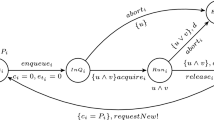Abstract
The aim of this paper is to show, how a multitasking application running under a real-time operating system compliant with an OSEK/VDX standard can be modeled by timed automata. The application under consideration consists of several non-preemptive tasks and interrupt service routines that can be synchronized by events. A model checking tool is used to verify time and logical properties of the proposed model. Use of this methodology is demonstrated on an automated gearbox case study and the result of the worst-case response time verification is compared with the classical method based on the time-demand analysis. It is shown that the model-checking approach provides less pessimistic results due to a more detailed model and exhaustive state-space exploration.
Similar content being viewed by others
References
Alur R, Dill DL (1994) A theory of timed automata. Theor Comput Sci 126:183–235
Alur R, Henzinger TA, Vardi MY (1993) Parametric real-time reasoning. In: Proceedings of the 25th ACM symposium on theory of computing, pp 592–601
Alvarez JM, Diaz M, Lopis L, Pimentel E, Troya JM (2003) Integrating schedulability analysis and design techniques in SDL. Real-Time Syst 24:267–302
Bailey CM, Burns A, Wellings AJ, Forsyth CH (1995) A performance analysis of a hard real-time system. Control Eng Pract 3(4):447–464
Berard B, Bidoit M, Finkel A, Laroussinie F, Petit A, Petrucci L, Schnoebelen P, McKenzie P (2001) Systems and software verification: model-checking techniques and tools. Springer, New York
Bucci G, Fedeli A, Sassoli L, Vicario E (2004) Timed state space analysis of real-time preemptive systems. IEEE Trans Softw Eng 30(2):97–111
Buttazzo G (1997) Hard real-time computing systems: predictable scheduling algorithms and applications. Kluwer Academic, Boston
Campos S, Clarke E (1999) Analysis and verification of real-time systems using quantitative symbolic algorithms. J Softw Tools Technol Transf 2(3):260–269
Corbett JC (1996) Timing analysis of Ada tasking programs. IEEE Trans Softw Eng 22(7):461–483
Daws C, Olivero A, Tripakis S, Yovine S (1996) The tool kronos. In: Proceedings of hybrid systems III, verification and control. Lecture notes in computer science, vol 1066. Springer, New York, pp 208–219
Fersman E, Pettersson P, Yi W (2002) Timed automata with asynchronous processes: schedulability and decidability. In: Proceedings of 8th international conference on tools and algorithms for the construction and analysis of systems, TACAS 2002. Lecture notes in computer science, vol 2280. Springer, New York, pp 67–82
Fersman E, Pettersson P, Yi W (2003) Schedulability analysis using two clocks. In: Proceedings of TACAS’03. Lecture notes in computer science, vol 2619. Springer, New York, pp 224–239
Fredette AN, Cleaveland R (1993) RTSL: a language for real-time schedulability analysis. In: Proceedings of the real-time systems symposium. IEEE Computer Society Press, pp 274–283
González Harbour M, Gutiérrez García JJ, Palencia Gutiérrez JC, Drake Moyano JM (2001) MAST: modeling and analysis suite for real time applications. In: Proceedings of 13th euromicro conference on real-time systems, Delft, The Netherlands. IEEE Computer Society Press, pp 125–134, June
Henzinger T, Kopke P, Puri A, Varaiya P (1998) What’s decidable about hybrid automata? J Comput Syst Sci 57:94–124
Klein M, Ralya T, Pollak B, Obenza R, Harbour MG (1993) A practitioner’s handbook for real-time systems analysis. Kluwer Academic, Dordrecht
Krákora J, Waszniowski L, Píša P, Hanzálek Z (2004) Timed automata approach to real time distributed system verification. In: Proceedings of 5th IEEE international workshop on factory communication systems, WFCS, Vienna, September 22–24, 2004, pp 407–410
Krčál P, Yi W (2004) Decidable and undecidable problems in schedulability analysis using timed automata. In: Proceedings of TACAS’04. Lecture notes in computer science, vol 2988. Springer, New York, pp 236–250
Larsen KG, Pettersson P, Yi W (1995) Model-checking for real-time systems. In: Proceedings of the 10th international conference on fundamentals of computation theory. Lecture notes in computer science, vol 965. Springer, New York, pp 62–88
Larsen KG, Petterson P, Yi W (1997) UPPAAL in a nutshell. Int J Softw Tools Technol Transf 1(1/2):134–152
Larsen KG, Larson F, Pettersson P, Yi W (2003) Compact data structures and state-space reduction for model-checking real-time systems. Real-Time Syst 25:255–275
Lime D, Roux OH (2004) A translation based method for the timed analysis of scheduling extended time Petri nets. In: Proceedings of the 25th IEEE international real-time systems symposium, December 2004, Lisbon, Portugal, pp 187–196
Liu JWS (2000) Real-time systems. Prentice-Hall, Upper Saddle River
Lundqvist K, Asplund L (2003) A ravenscar-compliant run-time kernel for safety-critical systems. Real-Time Syst J 24(1):29–54
OSEK (2005) OSEK/VDX operating system specification 2.2.3, http://www.osek-vdx.org/
Palencia JC, Harbour G (1998) Schedulability analysis for tasks with static and dynamic offsets. In: Proceedings of the 19th IEEE real-time systems symposium. IEEE Computer Society Press, p 26
Sha L, Klein M, Goodenough J (1991) Rate monotonic analysis for real-time systems. In: Foundations of real-time computing: scheduling and resource management. Kluwer Academic, Boston, pp 129–155
Tindell K, Clark J (1994) Holistic schedulability analysis for distributed hard real-time systems. Microprocess Microprogram 50(2–3):117–134
Wang S, Tsai G (2004) Specification and timing analysis of real-time systems. Real-Time Syst 28:69–90
Waszniowski L, Hanzálek Z (2005) Over-approximate model of multitasking application based on timed automata using only one clock. In: Proceedings 19th IEEE international parallel and distributed processing symposium IPDPS 2005 (Workshop 2: parallel and distributed real-time systems). IEEE Computer Society, p 128
Author information
Authors and Affiliations
Corresponding author
Rights and permissions
About this article
Cite this article
Waszniowski, L., Hanzálek, Z. Formal verification of multitasking applications based on timed automata model. Real-Time Syst 38, 39–65 (2008). https://doi.org/10.1007/s11241-007-9036-z
Published:
Issue Date:
DOI: https://doi.org/10.1007/s11241-007-9036-z




